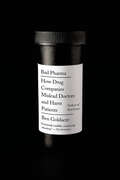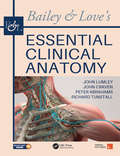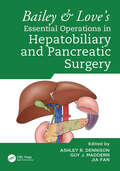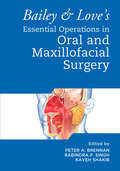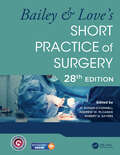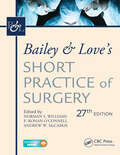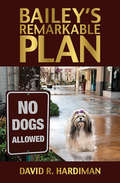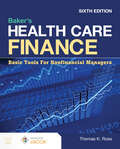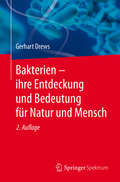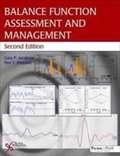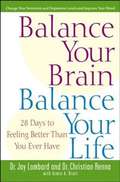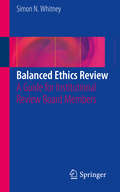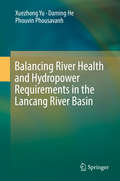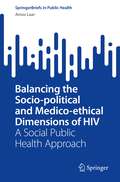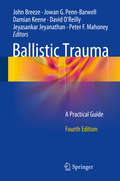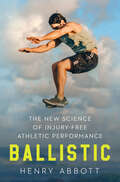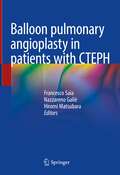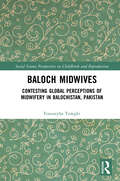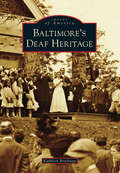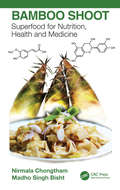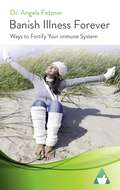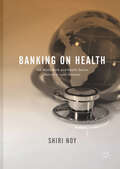- Table View
- List View
Bad Pharma: How Drug Companies Mislead Doctors and Harm Patients
by Ben GoldacreWe like to imagine that medicine is based on evidence and the results of fair testing and clinical trials. In reality, those tests and trials are often profoundly flawed. We like to imagine that doctors who write prescriptions for everything from antidepressants to cancer drugs to heart medication are familiar with the research literature about a drug, when in reality much of the research is hidden from them by drug companies. We like to imagine that doctors are impartially educated, when in reality much of their education is funded by the pharmaceutical industry. We like to imagine that regulators have some code of ethics and let only effective drugs onto the market, when in reality they approve useless drugs, with data on side effects casually withheld from doctors and patients. All these problems have been shielded from public scrutiny because they're too complex to capture in a sound bite. But Ben Goldacre shows that the true scale of this murderous disaster fully reveals itself only when the details are untangled. He believes we should all be able to understand precisely how data manipulation works and how research misconduct in the medical industry affects us on a global scale. With Goldacre's characteristic flair and a forensic attention to detail, Bad Pharma reveals a shockingly broken system and calls for regulation. This is the pharmaceutical industry as it has never been seen before.
Bailey & Love's Essential Clinical Anatomy
by Peter H. Abrahams John S. Lumley John L. Craven Richard G. TunstallThis essential companion to Bailey & Love's Short Practice of Surgery covers the clinical conditions most commonly encountered by medical students, junior clinicians,and surgeons in training. This is clinical anatomy at its best ! Structured by body region, each chapter includes plentiful clinical photographs and images supplementing the high-quality anatomical diagrams, using the best modality to demonstrate anatomical relevance. Highlighted descriptions of clinical relevance emphasise the integrated approach so central to current teaching practice, and facilitated by the wealth of both clinical and anatomical experience of the distinguished author team.
Bailey & Love's Essential Operations in Hepatobiliary and Pancreatic Surgery (Bailey & Love's Essential Operations)
by Guy J. Maddern Jia Fan Ashley R. DennisonBailey & Love's Essential Operations in Hepatobiliary and Pancreatic Surgery provides step-by-step explanations of both the core operations and more complex procedures. Written by acknowledged experts and trainers from around the world, and with abundant diagrams and figures to explain the operative steps, this new resource will enable hepatobiliary and pancreatic surgeons to increase their skills in this demanding and technically challenging field.Over 70 easy-to-read chapters cover the entire range of HPB surgery. Essential management principles and technical points are included, preferred operative techniques are described and alternative options discussed. The practice of HPB surgery requires familiarity and expertise with a wide range of technologies, and these are described and integrated within the text. The text is enhanced by clear colour images, ensuring that best practice in HPB surgery is made clear and accessible for a global audience.As surgical trainees around the world continue to be faced with the reduction in training time, surgical skills need to be increasingly codified so that trainees can reach a high level of proficiency as quickly as possible. This manual ensures that surgeons will be able to access the core information that they need quickly and with ease, and in the process increase their clinical judgement, their experience and their technical skills.
Bailey & Love's Essential Operations in Oral & Maxillofacial Surgery
by Peter A. Brennan Rabindra P. Singh Kaveh ShakibA new oral and maxillofacial operative manual in Bailey & Love's Essential Operations series. Covering all the surgical techniques across the entire remit of the specialty, written by acknowledged experts and trainers, and with abundant diagrams and figures to explain the operative steps, this new resource will benefit oral and maxillofacial surgeons in training and in practice. The content encompasses coverage of safe surgical practice, including human factors, and includes detailed coverage of the major OMFS sub-specialties: Oral Surgery and Implantology, Trauma, Oncology, Reconstructive Surgery, Salivary Gland and Thyroid Surgery, Temporomandibular Joint Disorders, Orthognathic and Craniofacial Surgery, Cleft Lip and Palate, Facial Aesthetic Surgery, and Advances in Operative Oral & Maxillofacial Surgery. Trainees in oral and maxillofacial surgery must grasp the basic principles of operative surgical practice before developing skills and competence in a variety of OMFS procedures. This practical operative text ensures that OMFS surgeons are well prepared for a wide range of procedures, thus ensuring optimal surgical performance and patient outcomes.
Bailey & Love's Short Practice of Surgery - 28th Edition
by P. Ronan O'Connell Andrew W. McCaskie Robert D. SayersThe 28th edition of Bailey & Love’s Short Practice of Surgery is the leading surgical resource for medical students and surgeons in training. It encompasses the basic principles of careful history taking, observation, deductive reasoning, technical knowledge and post-operative patient care to ensure safe surgical practice.Key features Relevant - the content matches both undergraduate and post-graduate curriculae Readable – features summary boxes of core knowledge throughout the text. The consistent layout and style of tables, graphics, and diagrams aids easy understanding of key concepts. Also includes algorithms to assist the reader in understanding patient care pathways Current- highlights where major developments in surgical practice have occurred or are likely to transform surgical practice in the next decade Contemporary – includes expanded coverage of paediatric surgery and of transplant surgery. Emphasizes the importance of the multidisciplinary team approach, together with patient engagement in difficult decision making Authoritative – every chapter has been revised by expert authors, and the most up to date content has been included in a familiar format Digital Resources – Readers can access extra content via the dedicated Bailey and Love website which includes Questions and Answers, Expanded Content, Videos, Author interviews and more Bailey & Love’s Short Practice of Surgery 28th edition continues to provide the essential knowledge required for surgical training. It remains a familiar friend, venerated by generations of medical students as well as surgeons young and old as a rite of passage and a repository of the core learning needed for clinical practice.
Bailey and Love's Short Practice of Surgery (27th Edition): The Collector�s edition
by Norman Williams P Ronan O'Connell Andrew McCaskieBailey & Love is the world famous textbook of surgery. Its comprehensive coverage includes the scientific basis of surgical practice, investigation, diagnosis, and pre-operative care. Trauma and Orthopaedics are included, as are the subspecialties of plastic and reconstructive, head and neck, cardiothoracic and vascular, abdominal and genitourinary surgery. The user-friendly format includes photographs, line diagrams, learning objectives, summary boxes, biographical footnotes, memorable anecdotes and full-colour page design. This book's reputation for unambiguous advice make it the first point of reference for student and practising surgeons worldwide.
Bailey's Remarkable Plan
by David R. HardimanAn inspiring memoir that &“shows how service dogs can save lives . . . Hardiman shares his story of faith and perseverance&” (North Dallas Gazette.com).A dog. A man. A miracle. In Bailey&’s Remarkable Plan, David R. Hardiman shares his poignant story of struggle, prejudice, and pain. But this is also a story of perseverance, triumph, and love. Hardiman discovers that his four-footed companion, delivered to him by chance, is more than his best friend. Bailey is also his service dog, a shih tzu with an extraordinary gift—part of God&’s &“remarkable plan&”—that allows her to assist, to protect, and to love.Bailey&’s Remarkable Plan will inspire you, inform you, and challenge you to feel compassion for those suffering silently among us because of circumstances beyond their control. God sent Bailey to this earth as part of His plan, an angel in the form of a remarkable dog. Not the typical service dog, Bailey performs a miracle in the life of her owner and friend. And Hardiman&’s story will touch your heart as you journey along with the boy who became a man encircled by love.&“This book takes the reader on the author&’s decades-long journey living with a rare medical condition coupled with post-traumatic stress disorder and Bailey&’s intuitive ability to help him cope.&”—Fort Worth Magazine&“Bailey&’s Remarkable Plan is a powerful, true story about a service dog that breaks all stereotypes and reveals a timely message of hope.&”—Mike Norris, film director
Bailey's Research For The Health Professional
by Diana M. Bailey Angela N. Hissong Jennifer E. LapeYour guide to research and evidence-based practice This classic text explains the hows and whys of conducting and writing a research project. Step-by-step guidance shows you how to select topics; how to select the appropriate methodology and theoretical framework; how to collect, analyze, and interpret the data; and how to write, present, and publish your project.
Baker's Health Care Finance: Basic Tools for Nonfinancial Managers
by Thomas K. RossBaker's Health Care Finance: Basic Tools for Nonfinancial Managers, Sixth Edition is the most practical and applied text for those who need a basic and better understanding of health care financial management. Using actual examples from hospitals, long-term care facilities, and home health agencies, this user-friendly text includes practical information for the nonfinancial manager charged with budgeting
Bakterien - ihre Entdeckung und Bedeutung für Natur und Mensch
by Gerhart DrewsVon den Anfängen naturwissenschaftlichen Denkens in der Antike über das Mikroskop bis zur synthetischen Biologie. Mikroorganismen leisten einen wesentlichen Beitrag zum Kreislauf der Stoffe in der Natur. Sie haben die Voraussetzung für das Leben der höheren Organismen geschaffen und synthetisieren wichtige Wirkstoffe wie Vitamine und Antibiotika. Gerhart Drews schildert die Ideengeschichte der Mikrobiologie. Er bringt dem Leser die Welt einiger Denker, Forscher und auch wissbegieriger Laien aus vergangenen Jahrhunderten näher. Er beschreibt die wesentlichen Entdeckungen, die zur Erkennung der Mikroorganismen, ihrer Rolle in der Natur und bei der Entstehung von Krankheiten geführt haben. In der modernen Zeit schildert er die Entwicklung exemplarisch anhand einzelner Organismen oder Themenfelder unter Einbeziehung der wesentlichen Entdeckungen in Molekularbiologie und Genetik. In der 2. , überarb. und aktual. Auflage sind einige Kapitel erweitert.
Balance Function Assessment And Management
by Gary Jacobson Neil ShepardBalance Function Assessment and Management continues to address the assessment and treatment of balance system impairments through contributions from top experts in the areas of dizziness and vertigo. Designed for use in graduate audiology programs and by practicing audiologists.
Balance Your Brain, Balance Your Life: 28 Days to Feeling Better Than You Ever Have
by Armin A. Brott Jay Lombard Christian RennaExplaining why an imbalance in our brain chemistry is behind a range of health problems, this book tells us what we can do to restore balance and achieve unprecedented levels of physical, mental, and emotional well being. It also explains how to treat serious imbalances, in consultation with a physician, using hormones, antidepressants, and more.
Balanced Ethics Review: A Guide for Institutional Review Board Members
by Simon N. WhitneyThis manual will help Institutional Review Boards (IRBs) conduct ethics review that balances the major moral considerations in research with human subjects. Current challenges in the IRB environment are addressed with arguments and insights from dozens of scholars. Useful to the IRB member at any level of experience, Balanced Ethics Review provides the necessary tools needed to create a systemic blueprint for promoting the research and dissemination of scientists and scholars within the standard norms of regulation.
Balancing River Health and Hydropower Requirements in the Lancang River Basin
by Daming He Xuezhong Yu Phouvin PhousavanhThis book assesses river health in the Lancang River Basin with regard to the impacts of hydropower projects. It studies key components of the transboundary effects of Chinese dams on the Lancang River including its hydrology, sediment transport, water temperature, and fish community. It also investigates the specific impacts of hydropower on women’s lives and livelihoods, and factors that influence women’s participation in river health management. In closing, the lessons learned regarding environmental protection and hydropower development in the Lancang River Basin are shared, e.g. with hydropower developers and regulators in Laos.
Balancing the Socio-political and Medico-ethical Dimensions of HIV: A Social Public Health Approach (SpringerBriefs in Public Health)
by Amos LaarResponding to public health challenges at the global and local levels can give rise to an array of tensions. To assure sustainable public health, these tensions need to be meaningfully balanced. Using empirical evidence and lived experiences relating to HIV from the global south, this book enunciates the many dimensions of national-level responses to HIV/AIDS including conceptual, philosophical, and methodological perspectives from public health, public policy, bioethics, and social sciences. Calling out glaring neglects, the book makes a bold recommendation for the destabilization of the naturalness with which national HIV/AIDS responses ignore the socio-political and medico-ethical dimensions of HIV. The case made is grounded in the philosophy of social public health. Such a critical perspective is not unique to Ghana’s response to HIV/AIDS but serves as emblematic voice for similarly situated settings of the global south. The book is also timely. It is written at a time when public health actors are repositioning themselves to be competent users of not only pharmaceutic vaccines, but also social vaccines. Topics explored in the chapters include:Public health approaches to HIV and AIDSAccess to life-saving public health goods by persons infected or affected by HIV“They are criminals”: AIDS, the law, harm reduction, and the socially excludedDeveloping socially and ethically responsive National AIDS policiesBalancing the Socio-political and Medico-ethical Dimensions of HIV: A Social Public Health Approach is compelling reading for a broad spectrum of readers. The book will appeal to professionals, scholars, and students in public health, public policy, bioethics, and social sciences, as well as medical anthropologists, sociologists, and global health scholars. Public health economists, lay politicians, and civil society organizations advocating for health equity will find the book useful as well.
Ballerina Dreams: A True Story
by Lauren ThompsonFive adorable little girls are given the opportunity to learn to dance like ballerinas and eventually perform on stage. This is no small accomplishment since the girls have cerebral palsy and other muscle disorders and several wear leg braces.
Ballistic Trauma: A Practical Guide
by Peter F. Mahoney John Breeze Jowan G. Penn-Barwell Damian Keene David O’reilly Jeyasankar JeyanathanBallistic Trauma: A Practical Guide provides a concise guide to the clinical and operational issues surrounding the management of the ballistic casualty. The book crystallizes the knowledge and experience accrued by those dealing with ballistic trauma on a regular basis and extends this to those who have to manage these patients on an occasional basis only. This book is aimed at all medical and paramedical personnel involved in the care of patients with ballistic injury. It will be especially relevant for consultants and senior trainees in surgery, anesthesia and emergency medicine who are likely to be involved in the management of these unique injuries. It will be an essential reference for pre-hospital care providers and nurses working in the emergency room and intensive care. Military surgeons and medical and nursing staff on deployment in regions of conflict will find the book a valuable resource.
Ballistic: The New Science of Injury-Free Athletic Performance
by Henry AbbottA Next Big Idea Club Must-Read Injuries are not destiny. This revolutionary new account of the science of injury prevention shows how “ballistic” movement can help you get strong, stay healthy, and be elite. The biggest victories of medical science—over polio, smallpox, heart attacks, and the like—are stories of prevention. Then there’s sports, where we just run around until something breaks, leading to pain, frustration, and sometimes even expensive surgery. Injuries are a major cause of society’s growing mobility crisis. What if we could predict and prevent them? Blending cutting-edge science with gripping storytelling, award-winning data journalist and competitive amateur athlete Henry Abbott reveals that we are on the cusp of a new era in sports medicine, built around the science of ballistic movements—leaping and landing—and the unique fingerprint of your body’s physics. Abbott’s inspiring narrative tells the story of sports scientist Dr. Marcus Elliott and the Peak Performance Project (P3), who use technology to study how athletes move and why they get hurt. Applying machine learning and lessons from biomechanics, medicine, and physiology, doctors at P3 can now detect elevated risk of an ACL tear or a pulled hamstring like an echocardiogram can see warning signs of a heart attack. Their data-driven findings are full of surprises. Your body’s most important defense against knee and ankle injuries are the little-known muscles in the lower leg and hip area, which typical workouts rarely target. Similarly, the glutes—not the core—do the most to prevent back pain. Transformative benefits flow from training underappreciated kinds of athleticism like rotation, deceleration, and relaxation. Most of all, science shows that the best athletes don’t avoid ballistics—they master them. Through riveting stories of elite athletes overcoming injuries and pushing themselves to the limit, Abbott presents an evidence-based case for intervening early to protect our bodies. And he suggests that we can all harness the science of ballistic movement not just to run fast or jump high but to move with joy and lead fulfilling athletic lives.
Balloon pulmonary angioplasty in patients with CTEPH
by Francesco Saia Nazzareno Galiè Hiromi MatsubaraThe only curative treatment currently available for chronic thromboembolic pulmonary hypertension (CTEPH) is surgical pulmonary endoarterectomy (PEA). However, several patients may have high risk factors for surgery, or a peripheral disease not amenable to surgical treatment; or else a residual pulmonary hypertension after PEA. Balloon pulmonary angioplasty (BPA) was recently developed to offer an alternative treatment for these patients. Extensive data has since confirmed the efficacy and relative safety of this procedure. However, there are several technical issues that have yet to be resolved. In addition, many cardiologists and pneumologists still know very little about the procedure itself and its potential.Exploring the clinical indications and technical aspects of BPA, this book offers a valuable reference guide for all those who would like to introduce or improve a BPA program, and for all those whose work involves treating this complex patient population.
Baloch Midwives: Contesting Global Perceptions of Midwifery in Balochistan, Pakistan (Social Science Perspectives on Childbirth and Reproduction)
by Fouzieyha TowghiThis book is the first major ethnography of Baloch midwives in Pakistan. Drawing on long-term ethnographic research in Balochistan province, it shows how dhīnabogs/dheenabogs (Baloch midwives ranging in age from about 30 to 80) and their dhīnabogirī (midwifery) aid women and their kin through labor and postpartum recovery.Its chapters show how Baloch midwives’ forms and ethics of care have persisted, despite nearly two centuries of British colonial policies and the subsequent disparaging official views regarding South Asian Indigenous midwives, commonly known as dāīs, in both postcolonial India and Pakistan. Through their continued presence and effective uses of their traditional medicine, Baloch midwives contain, mediate, and offer a powerful critique of women’s iatrogenic suffering caused by unnecessary biomedical interventions. Through a nuanced analysis of Baloch midwives' ethical approach to caring for women, and their responses to the exigencies of women’s health, this book demonstrates why over a century of state efforts to modernize and biomedicalize childbirth practices have failed to convince the majority of Baloch women in Balochistan to give birth in hospitals. They instead prefer home births and the midwifery care from the dhīnabogs whom they trust.This book will not only be of interest to scholars and students in anthropology, medical humanities, public health, sociology, gender and women’s studies, gender and medical history, South Asia studies, and global health studies, but also to those in the midwifery and the nursing profession. It will also be of interest to non-academic readers wishing to learn about midwives in South Asia and anyone interested in reading about traditional medicine and midwives who practice outside of European and North American cultural contexts.
Baltimore's Deaf Heritage
by Kathleen BrockwayThe booming job market and beautifully designed city of Baltimore attracted many families and individuals to the area in the 19th century. Several of these transplants would become prominent figures in the Deaf community. George W. Veditz, an early American Sign Language filmmaker and former president of the National Association of the Deaf; Rev. Daniel E. Moylan, founder of the oldest operational Methodist church for the deaf; and George Michael "Dummy" Leitner, a professional baseball player, all influenced Baltimore's growing deaf population. Through vintage photographs of successful organizations and sports teams, including the Silent Oriole Club, Christ Church of the Deaf, the Jewish Deaf Society of Baltimore, the Silent Clover Society, and the National Fraternal Society for the Deaf, Baltimore's Deaf Heritage illustrates the evolution of Baltimore's Deaf community and its prominent leaders.
Bamboo Shoot: Superfood for Nutrition, Health and Medicine
by Nirmala Chongtham Madho Singh BishtBamboo is an ordinary plant with extraordinary properties. With its high growth rate and self-renewing ability, bamboo’s sustainability is unparalleled. Bamboo is an important resource for a healthy planet, and its shoots hold manifold nutritional benefits. Based on 18 years of research, Bamboo Shoot: Superfood for Nutrition, Health and Medicine details health-promoting bioactive compounds found in bamboo and offers practical guidance on how this vegetable, bamboo shoot, is used for food fortification. Already a delicacy in many Asian countries, bamboo shoots aid in the prevention of cardiovascular disease, cancer, diabetes, hypertension and obesity. Exploring the tradition and culture of bamboo in Asian countries, this book also provides information on the science behind the nutritional value of bamboo shoots. Written by individuals with expertise in bamboo shoot nutrition and fully illustrated in colour, this book reveals the antioxidant activity of bamboo shoots and discusses the potential for bamboo to be used as an ingredient in functional foods and nutraceuticals. This highly practical book discusses processing and packaging of shoots for long term storage and using bamboo in the development of novel food products. Features: Elucidates the nutrients and phytochemicals in over 30 bamboo species and includes a glossary of scientific names Highlights the nutraceutical and antioxidant properties of bamboo Describes novel healthy food products fortified with bamboo shoots and provides food recipes using bamboo Explains how bamboo can help countries achieve their sustainable development goals, from poverty reduction, food security, improved nutrition and prevention of diseases to climate change mitigation and inclusive green economic development Aimed at professionals in the nutrition and food processing industry, this book appeals to those with an interest in incorporating bamboo into a healthier lifestyle. Endorsements This is a unique book interestingly crafted to highlight the important nutritional, health and medicinal aspects of Bamboo, an area that is greatly underexplored. It will bring awareness that bamboo shoots are a low calorie, high fibre nutritious vegetable packed with vitamins and minerals. - Prof. Cherla Sastry, Founding Director General INBAR and Adjunct Professor, University of Toronto, Canada This book brings a series of answers to all questions related to bamboo as a superfood [and will] enlighten readers how to transform bamboo shoots using either traditional or modern techniques, how to package them and how to use them as a functional and nutraceutical food. It also provides a series of cooking recipes for healthy eating while we enjoy our food. - Ximena Londoño, Founder, A Bamboo and Guadua Paradise, Colombia
Banish Illness Forever: Ways to Fortify Your immune System
by Dr Angela FetznerAdmittedly, the title “Banish Illness Forever” may sound provocative. But I’m sure you’ve noticed how some people have fortress-like protection against colds while others succumb to whatever infection is making the rounds. Are some of us predestined to get sick as soon as a sizable number of viruses and bacteria are around? By no means! All we have to do is hand our immune system the right tools, armory and suitable resources for it to build up adequate defenses against viruses and bacteria. A whole range of simple yet effective tricks and therapies exist which strengthen the body’s defenses, fortifying it against unwelcome diseases. If you take to heart what is said here about these measures, in no time at all you will be giving the cold shoulder to coughs and sneezes – and at the same time becoming fitter and healthier as you experience a completely new body sensation and feeling of well-being.
Banking on Health: The World Bank and Health Sector Reform in Latin America
by Shiri NoyThis book addresses the puzzle of why the World Bank was unable to effect sweeping neoliberal health reforms in Latin America from the 1980s onward. Through the use of quantitative regional data together with interview and archival data collected during fieldwork in Argentina, Costa Rica, Peru, and Washington DC, this book argues that the answer to this puzzle is twofold. First, the World Bank has not promoted a uniformly neoliberal, monolithic agenda in health. Second, countries' autonomy and capacity in this sector shape how the World Bank is involved in reforms. Finally, the book distinguishes neoliberal ends from means in health sector reform and traces changes in "banking on health" over time.
Banking on Milk: An Ethnography of Donor Human Milk Relations
by Tanya Cassidy Fiona DykesBanking on Milk takes the reader on a journey through the everyday life of donor human milk banking across the United Kingdom (UK) and beyond, asking questions such as the following: Why do people decide to donate? How do parents of recipients hear about human milk? How does milk donation impact on lifestyle choices? Chapters record the practical everyday reality of work in a milk bank by drawing on extensive ethnographic observations and sensitive interview data from donors, mothers of recipients and the staff of four different milk banks from across the UK, and visits to milk banks across Europe and North America. It discusses the ongoing pressures to do with supply, demand and distribution. An empirically informed "ethnography of the contemporary", where both biosociality and biopower abound, this book includes an exploration of how milk banks evolved from registering wet nurses with hospitals, showing how a regulatory culture of medical authority began to quantify and organize human milk as a commodity. This book is a valuable read for all those with an interest in breastfeeding or organ and tissue donation from a range of fields, including midwifery, sociology, anthropology, geography, cultural studies and public health.
